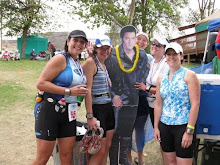Endurance Corner
We are now into the thick of the race season. Your "A" races are here or just around the corner. You've spent months planning your training and planning your life towards this part of the year.
Part of having a successful race is coming up with a solid plan for your event well before your race day. I like to use the technique of having athletes actually write out their race plans starting with the day before the race, race morning and the event itself. I feel there is value in actually writing it out, really thinking about it and then having it to read back to you before and after the event.
Long distance triathlon racing is long! In other sports you might consider 15 minutes to two hours a long endurance event. We plan on being out there racing all day and maybe even into the night. A lot can happen in this time. It is a long time to stay focused and cope with adversity. Ask yourself these questions:
- What are your expectations from the event?
- What are you hoping to achieve and learn from this event?
- How are you going to stay on task?
- What are your refocus strategies when things outside your plan are thrown at you?
- Has your preparation matched your expectations?
It's great to lay out a nutrition plan, a pacing plan, expectations of yourself and how you'll deal with each task physically, mentally and emotionality.
Some athletes are going into their events prepared to go after a win or a place; some are just hoping to finish. Each will have very different situations thrown at them throughout the day. For everybody, it's a long hard event that ultimately tests our ability to adapt and push on to what we set out to do. That is key in endurance racing: adapt and push on to what we set out to do.
It's good to keep in mind things like your power meter may just not work that day, or you may forget to bring your watch. The guy you were going to race all day and compare yourself to is hurt and pulled out. The mile markers may be set slightly off. The swim course could be set slightly off distance.
When you are out there racing the single most important skill I think you can use is your internal gauge of pushing yourself to your best each and every step of the way. Be a thinking athlete.
Are you taking care of the things necessary to have a successful long race? Are you fueling well? Are you holding a pace that you know you can handle based on your fitness level and race distance? Is your form under control? Are you relaxed and focused? These are all indicators I think you can dial in on race day and adapt and change to continue to be successful as the day goes on.
There are things in your control and things out of your control. Focus on the things within your control!
Remember why you started this journey and why you're out there on the course. Embrace the challenge of the day and enjoy the fact that you are out there doing what you love.
See you at the races.
For more Marilyn, drop by an Endurance Corner Camp. She will be sharing her experience at our June Boulder Camp and July Women's Camp. USAT coaches will earn 10 CEUs for each.





















